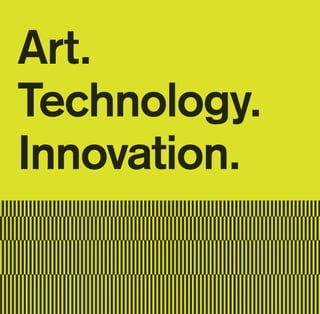
Culture Shock Manifesto
- 2. Philosophy.
- 3. All art expresses a worldview that is informed by direct experience of what it feels like to be human and alive at a particular moment in time. Science is knowledge and art is the application of knowledge. Both are trying to express what it means to be here, now. Paul Gauguin asked the big questions “The only definite location of “Where do we come from? What are we? Where are we going?” ‘now’ is ‘here’. In fact, every in his 1897 painting of the same title. man’s ‘now’ is ‘here’ (the ‘here’ He considered it a masterpiece and the culmination meaning where he is).” of all of his thoughts. —Guy Murchie “The Music Of The Spheres,” 1961
- 4. Art has always been the cultural barometer of the “As we learn more about the structures values and belief systems of its time. The Greeks of underlying reality, we confront growing used “deus ex machina” (literally “god out of the machine”) as a plot device to solve seemingly complexity instead of simplicity and add unsolvable problems. That’s the way the world felt more to the unknown than the known. back then. But along came Darwin with his “Origin Every solved mystery of the physical Of The Species” in the mid-nineteenth century, with dangerous ideas like the law of causality, and world immediately points to another one suddenly mankind felt that they had, or were soon beyond it… our inevitable ‘presence’ to have, all of the answers. Emile Zola urged for in nature compromises our necessary “Naturalism In The Theatre”. A caused B caused C and everything felt nicely linear. Man mattered, man scientific objectivity: protagonists and was confident, man was on an all-time high. observers, we are what we attempt to observe.” —Lincoln Barnett “The Universe And Dr. Einstein,” 1958
- 5. “We do not know what the next hundred The twentieth century felt a little less certain. Science led to two world wars and Einstein’s ideas led to years will bring, but we do know that the nuclear bomb. The universe revealed itself to nineteenth-century notions of reality be like an onion, where each layer revealed another and science represent a stage of human and another and another. Freud introduced the subconscious and sparked Surrealism, Pirandello development already superseded.” sent “Six Characters In Search Of An Author” to —Amos Vogel “Film As A Subversive Art,” 1974. interact with an audience, Picasso painted “Guernica” as a direct response to bombing by German and Italian Fascists, Beckett wrote “Waiting For Godot” “In our age, as never before, truth as an allegory on the Cold War and the A-Bomb at implies the courage to face chaos.” Bikini Atoll, and Warhol used multimedia to champion a future where everyone would be famous for fifteen —Erich Neuman “Art And The Creative minutes. Unconscious,” 1959
- 6. This is the twenty-first century. People walk around with cameras and microphones on phones in their pockets. Cultures are connected, globally. We live in a rapidly accelerated state of continual flux but still use linear, nineteenth-century models of engagement. Art is no longer a barometer of culture. Art has stayed still while the world around it has changed exponentially. Nanoscience and Quantum Physics have shown us that A does not necessarily cause B or C. The universe is way more complicated than we were led to believe. And it’s definitely non-linear. What we are advocating is a stylistic, thematic, technological, and ideological liberation from The audience is creative. The audience is ready. nineteenth-century art. There are now over 800 million It’s time for artists to ignite this collective creative active users on Facebook — creating, communicating consciousness with two-way models that turn and sharing. observers into protagonists across expanding social narratives. It’s time to make work that is relevant to here and now.
- 7. An Apocalypse (literally “lifting of the veil” or “revelation”) has nothing to do with destruction or the end of the world. It is a disclosure of something hidden from the majority of mankind in an era dominated by falsehood and misconception. It is the end of a lie. We have come a long way from believing that the sun is the centre of the universe and now know it’s just one of billions of stars in expanding space. What it means to be here, now, is very different from the 1800s. The majority of mankind has been led to believe that creative expression is the privilege of a select elite. Maybe 2012 is a good time for an Apocalypse after all?
- 8. “We think that art’s meant to characterize its time and explain what it’s like to be alive now. The art that sums up the present is on the Internet. It’s not in the galleries; it’s not in the museums... Outside feels like an accelerated present taking us toward some exciting future, but once you step inside it feels like the past — it’s as if Twitter doesn’t exist, it’s as if Facebook never happened.” —Hugh McGrory, Creative Director, Culture Shock From “Social Media as Inspiration and Canvas,” The New York Times, March 16th, 2011
- 10. Culture Shock is a New York City-based media Contact Us consultancy for creative industries. We grow and measure awareness, answer the big questions, t: 347.463.9023 make and curate. Our holistic method views clients f: 347.534.2494 and markets from a 360° perspective and presents e: hello@cultureshockny.com tailored solutions informed by seeing media as an ecosystem. We are recognized for strategic and w: cultureshockny.com creative approaches to content creation, art curation, marketing, brand development and positioning in global, digital and local markets. >Follow us on Twitter We believe that innovation happens when things that >Like us on Facebook are separate get mixed.
